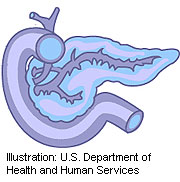Findings in patients with borderline resectable, locally-advanced pancreatic cancer
FRIDAY, June 12, 2015 (HealthDay News) — For patients with borderline resectable pancreatic adenocarcinoma (BRPAC) and locally-advanced PAC (LAPAC) treated with neoadjuvant chemoradiation (NACRT), dose escalation with a vessel boost (VB) correlates with a trend toward improvement in the surgical resection rate. These findings were published online June 12 in Practical Radiation Oncology.
Lora Wang, M.D., from the Fox Chase Cancer Center in Philadelphia, and colleagues conducted a retrospective review of cases with BRPAC and LAPAC treated with NACRT from 2006 through 2013. Data were included for 104 patients, of whom 22 percent received a VB and 78 percent received no boost. The rate of R0/R1 potentially curative surgical resection and acute toxicity were the primary end points.
The researchers found that more patients in the VB group were treated with intensity modulated radiation therapy (P = 0.002) and were treated from 2010 to 2013 (P < 0.001). There was a statistical trend toward increased surgical resection in patients who received a VB, after adjustment for covariates (odds ratio [OR], 2.77; 95 percent confidence interval [CI], 0.89 to 8.57; P = 0.077). Trends toward significance were also seen for age (≥70 years; OR, 0.42; 95 percent CI, 0.16 to 1.05; P = 0.064) and LAPAC (OR, 0.32; 95 percent CI, 0.09 to 1.09; P = 0.068).
“Dose escalation was associated with an improved surgical resection rate in BRPAC and LAPAC patients treated with NACRT, although this improvement was not statistically significant,” the authors write.
One author disclosed financial ties to Pfizer.
Copyright © 2015 HealthDay. All rights reserved.








